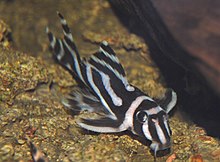Zebra pleco
| Zebra pleco | |
|---|---|

| |
| Juvenile. Photo: Birger A | |
| Scientific classification | |
| Domain: | Eukaryota |
| Kingdom: | Animalia |
| Phylum: | Chordata |
| Class: | Actinopterygii |
| Order: | Siluriformes |
| Family: | Loricariidae |
| Subfamily: | Hypostominae |
| Tribe: | Ancistrini |
| Genus: | Hypancistrus |
| Species: | H. zebra
|
| Binomial name | |
| Hypancistrus zebra | |
The zebra pleco (Hypancistrus zebra) is a species of catfish endemic to Brazil where it occurs in the Big Bend area of the Xingu River, a tributary of the Amazon River, and was first described in the early 1990s.[1] It gets its name from its black and white stripes, resembling the colouration of a zebra. This species grows to a length of 6.4 centimetres (2.5 in) SL.[1] This fish was exported from Brazil in great numbers for sale as aquarium fish. However, currently the Brazilian government bans the export of certain Hypancistrus, including H. zebra.
H. zebra is threatened by the construction of the Belo Monte Dam in the Xingu river which will cause a severe reduction of the water flow of the entire known distribution range of the species. Due to this, the species has been classified as endangered and may soon become extinct in the wild. It is subject to several captive breeding programs.
Mature males have a larger head and longer interopercular spines than females. After spawning, the males will guard the eggs. The fry swim after seven days and absorb the yolk sac in two weeks.[2]
In the aquarium
Hypancistrus zebra is called L046,L098,L173 in terms of the L-numbering convention often applied to Loricariidae. H. zebra is a predator, feeding on small invertebrates such as chironomid-larvae. It is extremely expensive, due to the fact it is rarely available. It is a hard fish to keep, as it needs clear water and a fast moving current. They are unable to survive in still water or dirty quarters.[2] It is nocturnal, moderately territorial, and prefers plenty of hiding places.[2]
See also
References
- ^ a b Froese, Rainer; Pauly, Daniel (eds.). "Hypancistrus zebra". FishBase. December 2011 version.
- ^ a b c Sanford, Gina (1999). Aquarium Owner's Guide. New York: DK Publishing. p. 40. ISBN 0-7894-4614-6.
- "Hypancistrus zebra". Integrated Taxonomic Information System. Retrieved 19 March 2006.
External links
- http://www.brianstropicals.com/pages/Zebra-plecos.html - export ban
- http://www.zebrapleco.com/ - a web-site dedicated to zebra pleco husbandry and breeding
